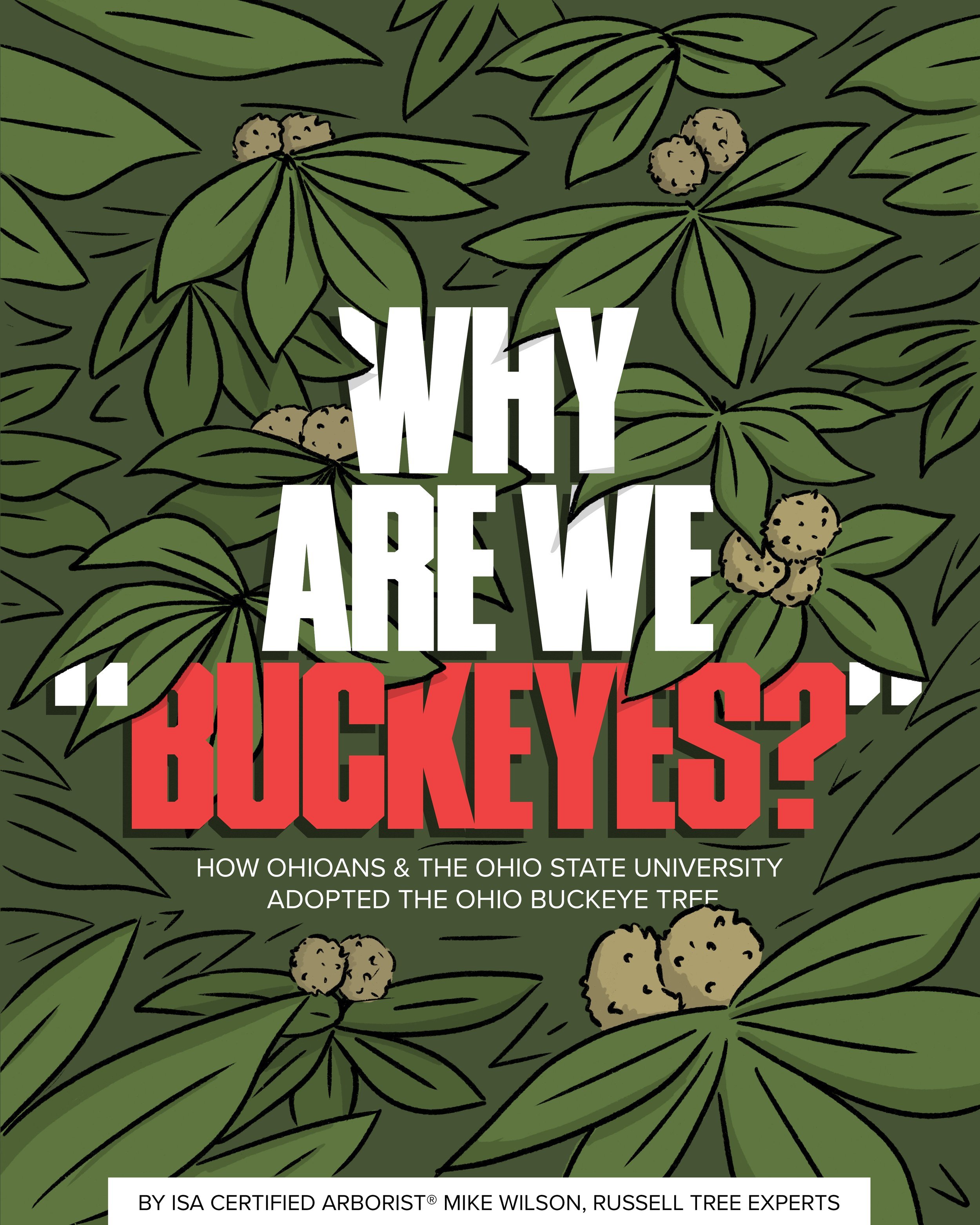By Enrique Arayata
ISA Certified Arborist® OH-7252A
May 8, 2024
When I started working at Russell Tree Experts as a video production intern (and now media production coordinator), I had no significant knowledge of arboriculture apart from taking courses in environmental science and world of plants in college. I graduated with an associate’s degree in web graphic design from DeVry University in 2018 and with a bachelor's degree in moving image production with a double minor in film studies and studio art with a specialization in photography from The Ohio State University in 2023 and there’s quite a stark contrast between cameras and trees. One of my notable follies is that an “acorn tree” is not a thing and that it is the genus Quercus that produces acorns. I have also been judged for the Colorado blue spruce tree being my favorite tree since it is not native to Columbus and is susceptible to rhizosphaera needle cast. Luckily, throughout my almost 5 years now of working here, I have picked up various things along the way from talking with coworkers, attending meetings and training sessions, researching for a video, and more!
However, now that I have completed school and have some additional free time outside of work, I have decided to take on my next challenge and study to become an ISA Certified Arborist®! To become an ISA Certified Arborist®, one must have at least 3 years of documentable experience in the tree industry (or a combination of formal education and practical arboriculture experience) and must pass the ISA Certified Arborist® Exam with at least a 76% or higher. To learn more about what it takes to become an ISA Certified Arborist®, check out this Arbor Ed article written by my fellow coworker (and ISA Certified Arborist®) Lindsey Rice or visit ISA’s website here.
In my personal life, I try to always be curious, open-minded, and willing to learn and improve, so attaining my ISA Certified Arborist® credential feels like a good, natural next step in my career! Throughout this journey, I hope to expand my knowledge of arboriculture which will help me produce better photos, videos, or written content like social media captions or Arbor Ed articles! I would consider earning this certification a success if I can learn more about arboriculture and be able to use my position and platform here at Russell Tree Experts to spread more knowledge to people that would inevitably lead to better and more informed care of our trees and environment. I do not have a strict target date for when I take the ISA certified arborist exam but as of the time of writing this article, I am currently on chapter 5 out of 16 in my study guide (the 4th Edition Arborists’ Certification Study Guide). So far in my 82 pages of studying, there have already been many important details and interesting facts that I have learned that can go a long way in ensuring the best long-term health for your tree. Below are just a few of many!
Leaves are Life
Leaves are important! Leaves are considered the “food factories” of a tree and have two important roles. First, leaves have cells with chloroplasts. Chloroplasts contain a great pigment known as chlorophyll which is the main leaf pigment that absorbs sunlight. Energy from the sun is collected in the chloroplasts for photosynthesis which converts the energy from sunlight into carbohydrates which is then used by the tree for growth and other processes within the tree. The second function of leaves is transpiration, which is the loss of water through a tree’s foliage in the form of water vapor, which in turn cools the leaf. Transpiration draws water up through the xylem from the roots. This is important for cooling a tree as this is essentially how evaporation occurs for a tree. Transpiration is also the driving force for water from the roots to travel up and through the tree to the shoots for growth. Transpiration is moderated by stomata, which are small openings commonly found on a leaf’s underside which controls the loss of water vapor and gas exchange by opening and closing like a door or gate.
Root for Your Roots
Roots are also important! They play four key roles in a tree with anchorage, storage, absorption, and conduction. Anchorage is a tree’s ability to stay anchored to the ground so that they do not fall over during adverse weather conditions. Storage is a tree’s ability to store water and nutrients that can be used in the future, such as during the winter months when nutrients might be scarce. Absorption is a tree’s ability to uptake minerals and water. Conduction is a tree’s ability to distribute food and water throughout other parts of the tree like in leaves and stems.
Supportive Soil
For some trees such as maples and oaks, iron and/or manganese deficiency in higher pH soils can lead to chlorosis, the yellowing or whitening of leaves. This is a symptom of a tree not functioning properly. This is one example of why having the proper pH for a tree is important.
Soil is more complex than you may think! Soil is generally composed of 3 materials: clay, silt, and sand. The percentage content of each of these 3 particles determine a large number of factors ranging from the soil’s physical properties like pore space, texture, structure, and bulk density, chemical properties like pH, buffering capacity, and cation exchange capacity (CEC), and biological properties like water holding capacity, food web, and more. All of these different properties are important because if they are not ideal or paired correctly with a particular species of a tree, its growth may be hindered, or the tree may even fail. Two examples are: (1) unideal soil pH can cause nutrient deficiency, and (2) soil compaction can inhibit water flow and gas exchange. Soil has its own diverse ecosystem commonly referred to as a soil food web containing fungi, bacteria, small mammals, earthworms, millipedes, mites, and other insects and organisms that are directly and indirectly beneficial to trees. Collectively, they help to maintain soil structure, decompose organic matter, and aid in nutrient cycling and nutrient mineralization which, to make a long topic short, helps make nutrients available for roots and trees.
Wealth in Water
Water is arguably the most important factor when it comes to a tree’s health. Leaves need water to perform photosynthesis. Roots are important for a tree so that it can uptake water and nutrients. Soil is important so it can hold and provide water for trees. With that said, too much of a good thing can be bad. Trees have adapted to their environment and some trees near coastlines or swamps are thirstier for more water in comparison to trees that have adapted to arid regions like deserts. Drought and heat can cause leaf scorch and leaf drop, twig dieback, or even tree death. Flooding and overwatering can lead to leaf discoloration, defoliation, and crown dieback. It is important to research the tree (or trees) you are considering planting and figure out its water needs. Your local nursery or online resources from colleges, nurseries, laboratories, and more can be helpful! Tools such as bubblers, sprinklers, slow-release watering buckets, soil probes, electronic moisture sensors, and tensiometers can be beneficial in monitoring and adjusting soil moisture. There are also strategies to better manage water for a tree like xeriscaping, the designing a landscape of drought tolerant plants, minimum irrigation, the providing of the minimum amount of water to maintain and not prohibit a tree’s health, growth, and appearance, and hydrozoning, the grouping plants and trees of similar water needs and irrigating on the same schedule. One interesting fact I learned is that recycled or reclaimed water from your home’s water supply can commonly be high in salts and other chemicals which can raise a soil’s pH. Depending on what is planted, this may be a nonissue, but for trees that prefer a slightly acidic soil, this can be a big problem. Learning more about your trees and plants and performing a test on your soil and/or water can be beneficial for you and your trees’ success!
— — —
There are so many important details that I have learned (and not mentioned because I would be here all day) about trees that are essential for their long-term health and survival. Above are just a few pieces of information that I found particularly interesting or useful! I plan on continuing my studies and will provide another update or two with more important details about trees that you might be able to apply to your tree’s maintenance. In the meantime, enjoy your landscape and the upcoming spring weather!
Check out these Arbor Ed Articles!
Sincerely,
Enrique Arayata I Media Production Manager, Russell Tree Experts
Enrique is an ISA Certified Arborist® and FAA Certified Remote Pilot. In his free time, he enjoys working out, hanging out with his family and girlfriend, video production, photography, cars, technology, and cooking. Enrique has a BA in moving image production with a double minor in film studies and studio art specializing in photography from The Ohio State University, and an AA in web graphic design from DeVry University. His favorite tree is the Kwanzan cherry tree.









